

Aside from an early war with Caesar, I managed to stay out of the fighting and peacefully built up my civ for ages on end. My Buddhist friends shielded me from those nasty AI civs, and my maritime civ actually managed to develop a decent tech lead while the others got dragged down in wars or were slowed from having to deal with barbarians. However, the peace couldn't last forever, and Alex declared war on me in 1715:
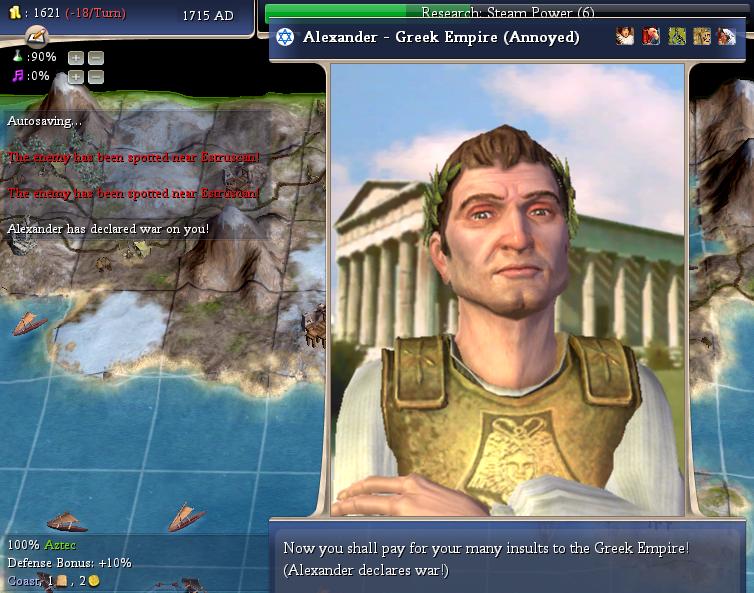
Eep!  Yet the truth of the matter is that I was in much better shape right now than I would have been 10 turns earlier, since all of my units had just recently been upgraded to rifles. Alex could outnumber me by quite a bit, and my rifles would be able to shoot down his medieval armies without breaking a sweat. Let's take a look at what he's bringing after me:
Yet the truth of the matter is that I was in much better shape right now than I would have been 10 turns earlier, since all of my units had just recently been upgraded to rifles. Alex could outnumber me by quite a bit, and my rifles would be able to shoot down his medieval armies without breaking a sweat. Let's take a look at what he's bringing after me:
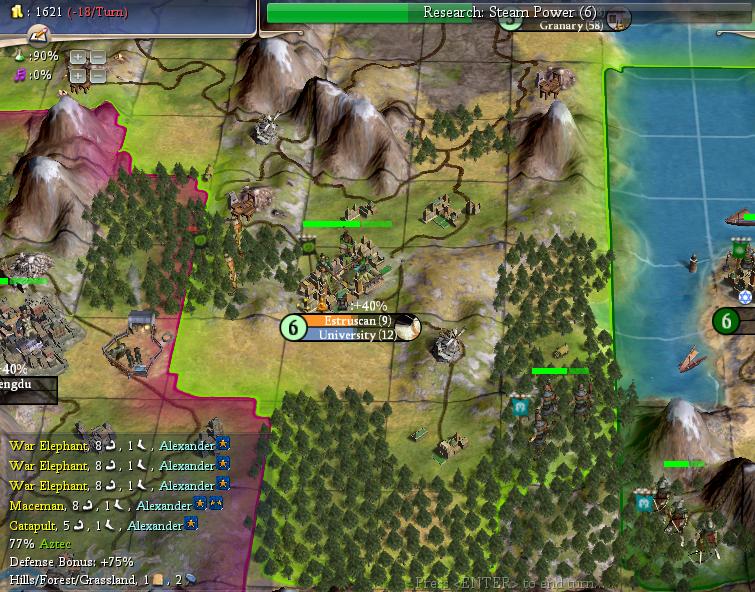
Mostly elephants with a few maces, crossbows, and cats thrown in. Excellent; my rifles will eat those elephants for breakfast. I scan the immediate area and see that I can pull seven rifles into Etruscan. That should be enough to deal with the first wave, but there could be more trouble behind that, of course. With that in mind, I dial up Caesar and pull him in on my side:
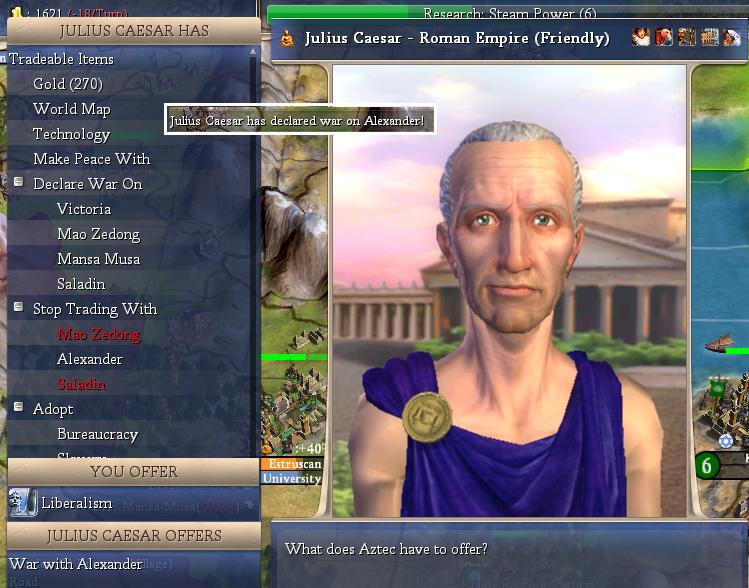
The only cost is the tech Liberalism, which every other civ already has (except Mansa Musa, but he no longer counts). Caesar still has that huge army you saw earlier walking around somewhere in the east (he captured a barb city up by Saladin), and my hope is that they'll get involved in the fighting somehow. Anyway, I'll have to deal with the initial attacks myself, so I make a note to start building some extra rifles.
That stack you saw in the above shot moves next to Etruscan, and my rifles blast Alex's elephants to smithereens:
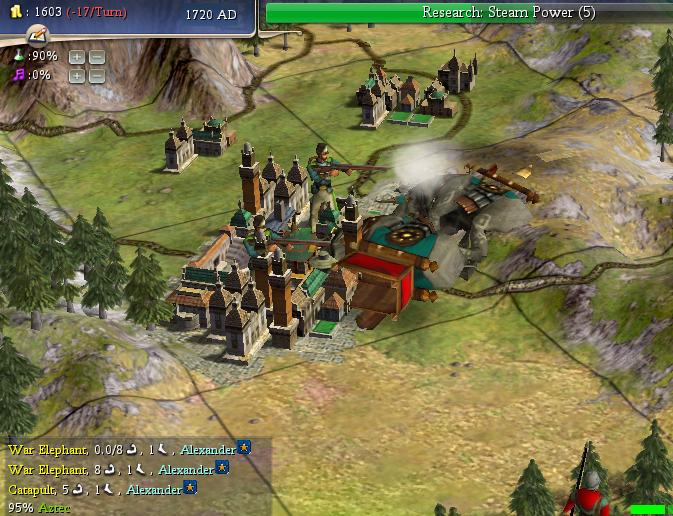
That was easy enough. Rifles make short work of cavs, so you can imagine what they do to elephants. I finish Oxford University in Tlatelolco in 1725, start building a rifle there for safety (that's very close to the front lines!) Two Greek units suicide against the defenses of Etruscan in 1730, and I clean up more of them as they split up to pillage on the following turn. Here's the situation in 1735:
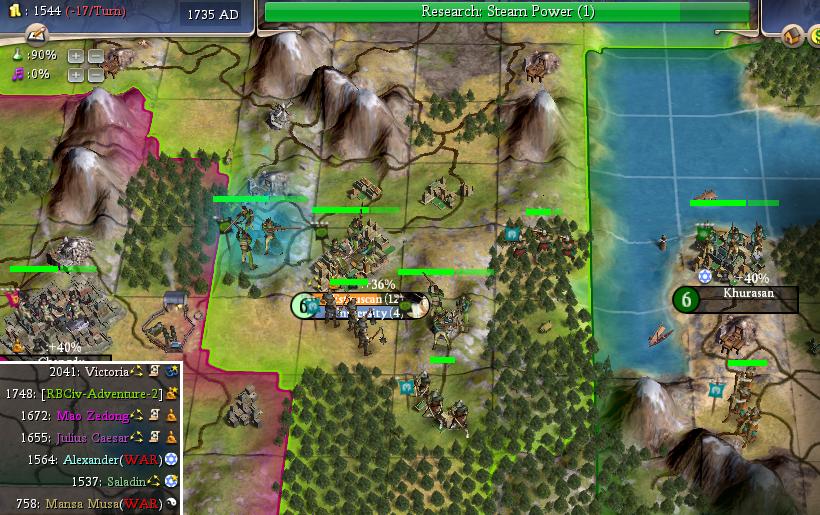
The first wave of units has effectively been destroyed by this point. I had a few tiles around Etruscan pillaged, but I still have not lost a single unit yet. It's extremely difficult to invade the territory of someone who has technologically superior units, and Alex was finding that out now. My units were taking injuries, but they were killing the other guys, and beginning to accumulate some decent experience too. I never could have taken the risks I did without being a generation ahead in military tech.
Discover Steam Power in 1740 and enter the Industrial Age. I have no coal - great. There has not been a single strategic resource near the starting position of this game. That's why we call it an "Extreme Adventure", kiddies!  There is a coal within reach to the southeast, however, in ground that no one has claimed yet. At the moment though, it is blocked by Greek units:
There is a coal within reach to the southeast, however, in ground that no one has claimed yet. At the moment though, it is blocked by Greek units:
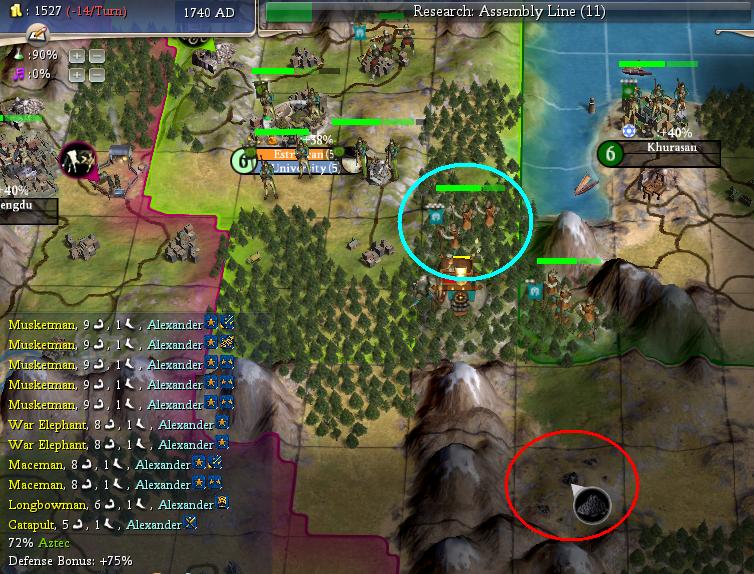
I have the coal circled in red; I plan to build a city ON the coal itself in the future and then just defend the throwaway city as best I can. For the moment, however, I have to deal with that incoming Greek stack, which is a lot scarier than anything I've seen thus far. Thank goodness there's only one cat in that stack, and that my defenders are rifles (gunpowder) instead of archery units! Alex probably launched this attack when I still had longbows in Etruscan; if I had not made it to Rifling and upgraded, there would have been no chance to hold the city. As is? Could get interesting if I can't get more reinforcements up to the front soon.
But there is good news. What's that? I just saved a bunch of money on my car insurance... err wait, no, I build the Statue of Liberty in Tenochtitlan. 
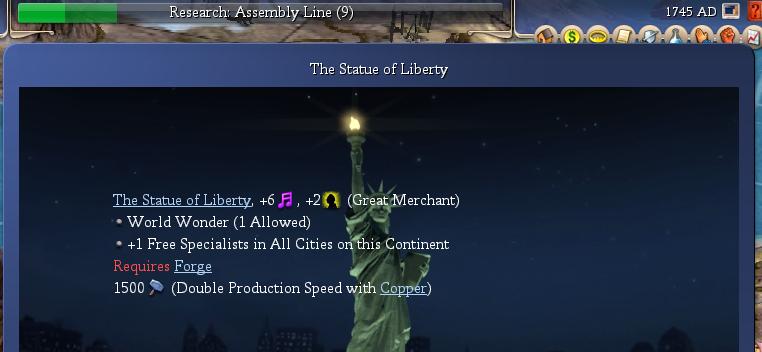
I choose to run Engineer specialists in almost every city, since shields are one thing that is in short supply. Thanks to Representation, I also get a minor science boost in every city too! On any pangaea-type map like this, the Statue is an extremely powerful wonder, especially when combined with Representation. I also generate another Great Scientist from the Great Library and send him to Tlatelolco (my Oxford city) to build an Academy and boost science further.
Meanwhile, MAJOR attack incoming on Etruscan. I don't have enough units to meet them in the field, so I fortify my rifles in the city and await the Greek attack. I'm outnumbered but get a number of defensive bonuses. Here they come!
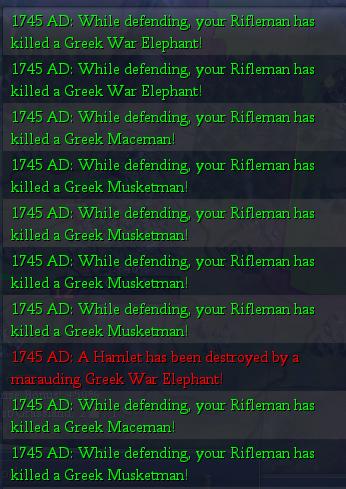
My rifles have a field day shooting down outdated Greek junk. When the smoke clears, here's the situation on the next turn in 1750:
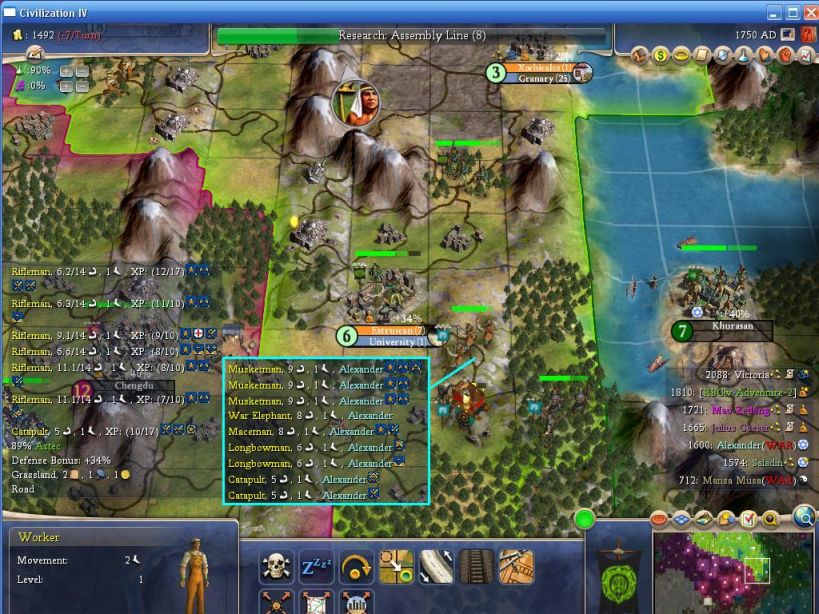
Even after killing NINE Greek units on the interturn, there are still a good number moving around in my territory. That stack next to Etruscan doesn't have much of a chance to take the city, but could potentially kill some of my injured defenders. Fortunately, the cats stopped to bombard the defenses and only some of the units attacked on the following turn. Three more Greek units attacked and died in 1755, and with only a few stragglers left, I took my time picking off the remnants. Still haven't lost a single unit to this point in time, the dice luck has been kind (that's the result of having the technological lead too, of course). By 1775, the last Greek unit has been cleared out and the invasion is over:
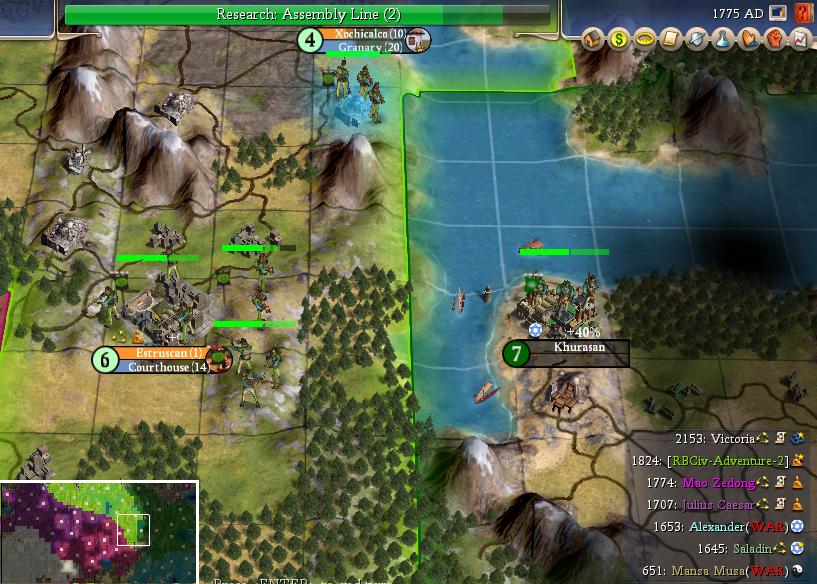
I lost one unit in the mopping up, attacking with 97% odds to win (oh well). Other than the pillaging, that was the only damage that Alex did to my civ. He flushed a lot of shields down the drain in that attack to achieve very, very little. The war is now over, I'm just waiting for the AI to realize it and talk with me so that we can discuss peace. And look, I'm about to discover Assembly Line and get to infantry! I'm starting to feel almost safe here. Peace finally signed with Alex in 1790, even getting him to chip in 70g in the deal. War reparations for damage caused to Azteskimo farmers!
I had made this deal with Mao a couple turns earlier for the one tech that I lacked:
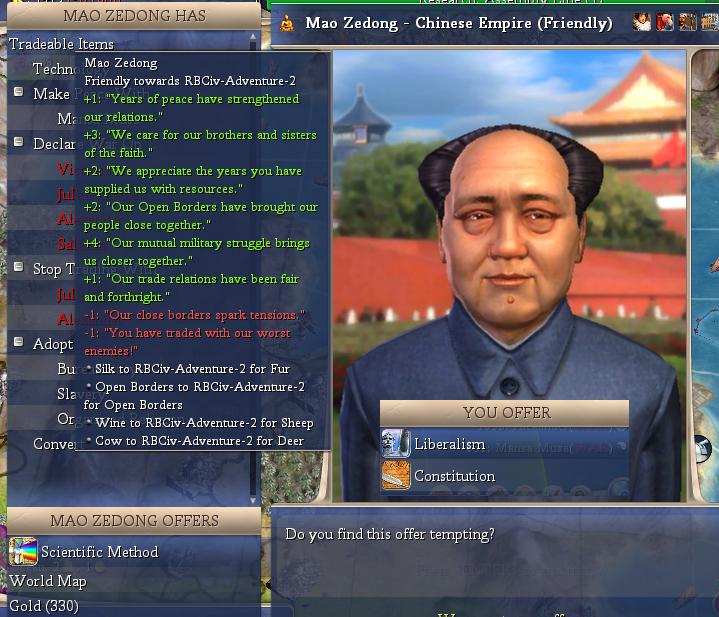
Remember, Liberalism was an old tech that most civs already had, and now that I had the Statue of Liberty, there was no reason not to trade Constitution. In return, I got Scientific Method and some change. That allowed me to go on and start researching Biology as soon as I finished Assembly Line. There were very few opportunities to chain irrigation on this map, but with Biology I could finally build farms without fresh water in many locations across my territory. Oh, and look at all those pluses I have with Mao. Yes, that's right, you wouldn't even think of attacking your Buddhist buddy!
Now one thing that I had decided to do a little bit earlier after seeing the monstrous science output of Tlatelolco was to start building the palace there, moving my capital south into the more fertile heart of my territory. Palace moves are rarer in Civ4 than in Civ3, since the land around the capital is usually very good, but since the land around the start was so bad in this game, I felt it would be a strong move. With the Great Library now obsolete, and shrine income unaffected by Bureaucracy civic, it was definitely the right time for the move. Here was Tlatelolco after I made the switch in 1806:
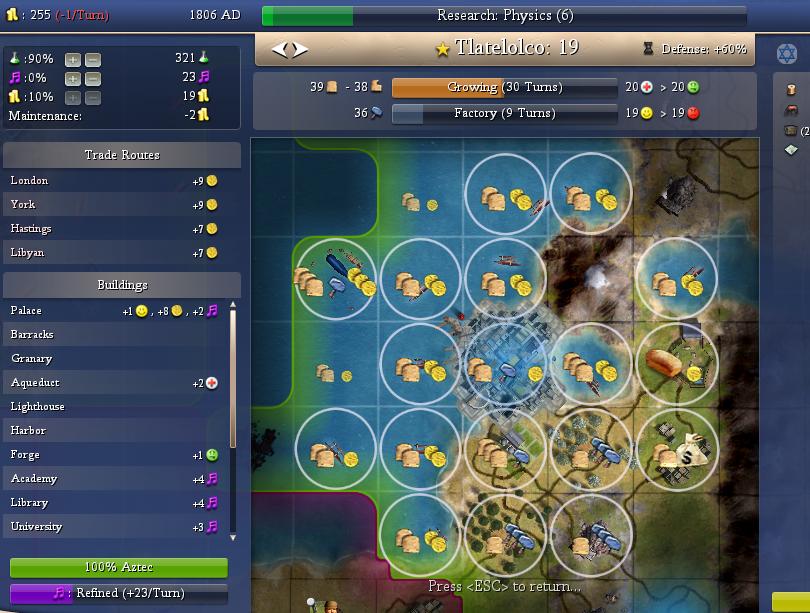
321 beakers - and I still don't have an observatory built there yet! Yes, I think that was a very profitable move there. Researching Physics now in the hopes of getting the free Great Scientist there; I've gotten all the other rewards on the tech tree for being "first" so far, so there's no reason not to expect to get that little goody as well.
I found a new city called Coal Town directly on the coal in 1812:
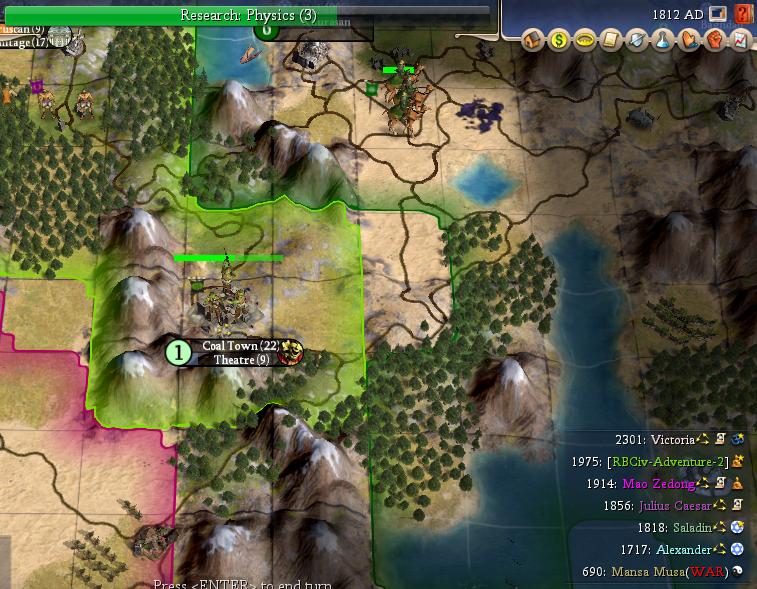
This city has worthless land and is dangerously exposed to AI aggression, but let's face it - I NEED coal to power my coal plants and build rails, and this is the only spot where I can get my hands on it. I pile half a dozen infantry into the city and begin trying to get some culture going so that my borders will push out a bit further. Coal Town now becomes the cornerstone of my defense of SE Corner.
Discover Physics in 1818 and start Electricity. I do get the Great Scientist, as expected, who I hold onto for now (he only gives me some 1500 beakers for a tech, and I can get that in two turns of research). I have only one source of uranium, and again it's not close at all to the starting position:
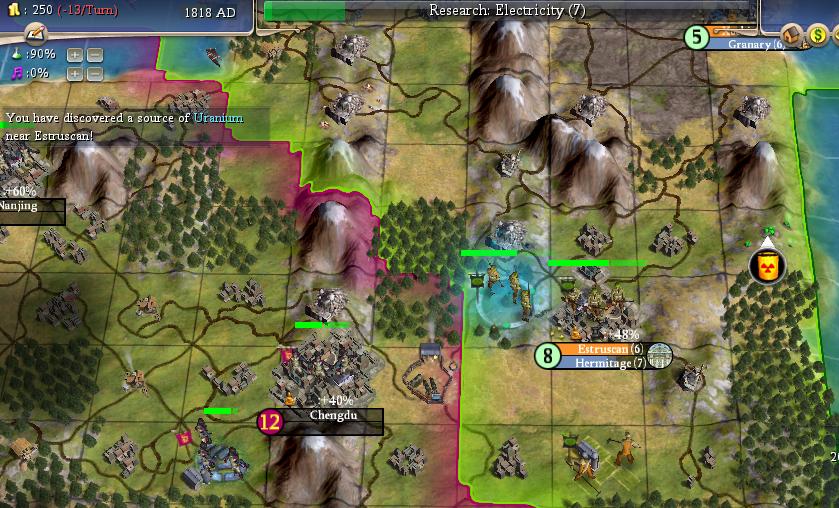
So there's another valuable resource in SE Corner. That reach location of Tlatelolco in the early game has paid off a thousandfold!  I have iron, coal, and uranium all down here. Horses and oil over at Calix on the east side of the lake, copper at Tlaxcala on the south side of the lake, iron at Bantu in the extreme west. Everyone is going to have to work for the resources in this game!
I have iron, coal, and uranium all down here. Horses and oil over at Calix on the east side of the lake, copper at Tlaxcala on the south side of the lake, iron at Bantu in the extreme west. Everyone is going to have to work for the resources in this game!
I ask Caesar to adopt Representation in 1824 and he does; since that's his favorite civic, it will further improve our relations (which had briefly dippled below Friendly to Pleased). Trade Mao Biology for Steel a few turns later and start the Iron Works in Bantu; basically just cruising along here. Discover Electricity in 1832, and that's a big deal because it increases the commerce output of my many windmills by another point. Let me give you a demonstration of what I call the windmill economy:
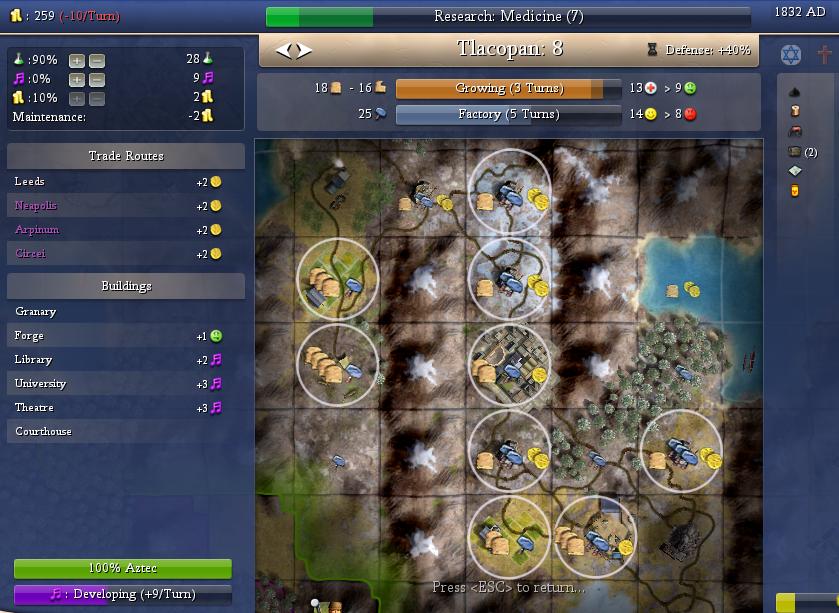
Tlacopan was a fill-in city stuck between Bantu and Tlaxcala, which itself was only founded to get copper. In its 21-tile radius, it has 7 useless peak tiles, 5 tundra hills, 2 ice hills, 1 plains hill, 2 "extravagent" flatland plains, and two resources: sheep and deer. Aside from the resources, this is as sad a location as you will ever see. And yet - with those two resources, and by irrigating the only flatland tiles possible, even this site can be made productive. By putting a windmill on every hill tile, this city can actually reach size 10. Look at all those windmills!  When it maxes out in size, the city will be working 6 windmills, each of which will provide 2 commerce. That's as good as a fishing town working 6 coastal tiles, so it's not irrelevant by any means. And look at the overall result: not only is this town costing me nothing, it's even getting 28 beakers per turn. With an observatory and lab, that will be over 50 by game's end. And with factory and coal plant, this city will actually get about 40 shields/turn.
When it maxes out in size, the city will be working 6 windmills, each of which will provide 2 commerce. That's as good as a fishing town working 6 coastal tiles, so it's not irrelevant by any means. And look at the overall result: not only is this town costing me nothing, it's even getting 28 beakers per turn. With an observatory and lab, that will be over 50 by game's end. And with factory and coal plant, this city will actually get about 40 shields/turn.
Not bad at all, but Tlaxcala has even poorer lands and produces even more commerce!
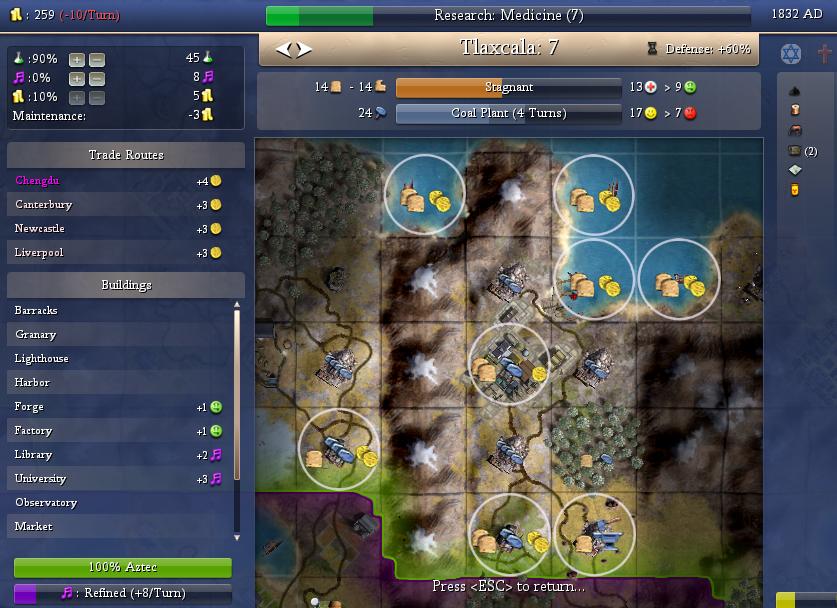
Tlaxcala was founded for only one reason, to get the copper resource, but it's proven to be more than just a simple cash drain. The land is horrible: 7 peak tiles, 2 tundra hills, a useless flatland tundra tile, four plains hills, and one LUXURIOUS grasslands hill tile. This city can never get past size 7. Size SEVEN! Yet - it's on the coast, and even those pitiful four water tiles are enough to make this city worthwhile. That allows me to build a lighthouse for food, a harbor to increase the trade route income, and provides enough commerce to make the city useful. And don't forget, I get a free Representation specialist in every city too that kicks in extra beakers. Not only is Tlaxcala not costing me money, it's also getting a very nice 45 beakers/turn. Nothing game breaking, but every little bit helps.
Where there is the sea, there is food. And where there is food, there is life. ANYTHING can be made productive if there's enough food. That is the true lesson of this game, whether you're running a windmill economy or a pitiful size seven fishing village. I hope that I'm opening some eyes here as to just how much can be done with truly atrocious land. 
Getting closer to the Modern Age now, but still a ways to go yet. The story continues on the next page.



